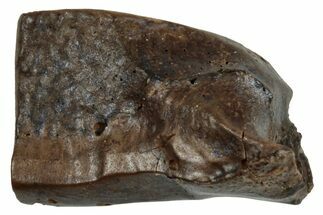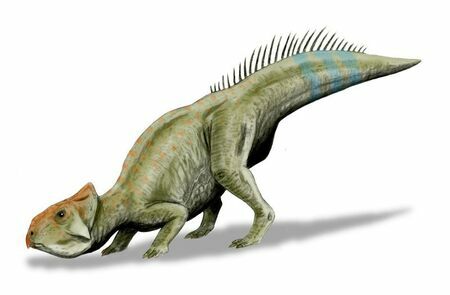This Specimen has been sold.
.42" Fossil Dinosaur (Leptoceratops) Shed Tooth - Wyoming
This is a .42" long tooth from the elusive ceratopsian dinosaur, Leptoceratops gracilis. It was collected from our partner's private lease on the Lance (Creek) Formation in Wyoming.
Leptoceratops gracilis is the only Leptoceratopsid (previously protoceratopsid) found in North America. Like Triceratops, they shed teeth during their lifetime and collectors often refer to these teeth as "spitters". This "spitter" has a polished upper surface indicative of a lot of wear from grinding food.
Comes with an acrylic display case.
Leptoceratops gracilis is the only Leptoceratopsid (previously protoceratopsid) found in North America. Like Triceratops, they shed teeth during their lifetime and collectors often refer to these teeth as "spitters". This "spitter" has a polished upper surface indicative of a lot of wear from grinding food.
Comes with an acrylic display case.
Leptoceratops was a small, primitive genus of ceratopsian dinosaur whose name literally means "small-horn face" despite the fact it did not have any horns. It reached lengths of about two meters and appears to have had the characteristics of a bipedal dinosaur, likely being able to stand and run on its back legs. However, even though they weren't able to pronate their "hands", it's likely they could walk on all four legs. As with other ceratopsians it has a parrot-like beak and was probably able to chew very tough vegetation.
The Lance Formation of Wyoming, which dates back to the Late Cretaceous period between 66 and 69 million years ago, is home to a wide variety of both dinosaur and assorted small vertebrate fossils. During the Cretaceous, this midwestern formation would have been comprised of streams connected to the large Western Interior Seaway that split continental North America in half down the midwest. As a result of the subtropical climate and frequent rainfall, life flourished both on land and in the sea. These wet environments created perfect scenarios for sediment deposition, making the resulting Lance Formation such a fertile fossil site.
Perhaps the most famous Lance resident would be Tyrannosaurus rex, the largest North American carnivore to ever live. However, other smaller theropods also roamed the American midwest in this subtropical coastal stream system, including the beaked Ornithomimus, a lanky running theropod with a build similar to a modern ostrich, as well as several small predatory troodonts such as Paronychodon and Pectinodon.
Herbivorous dinosaurs also took advantage of the abundance offered by this unique era. Armored ankylosaurs dwelt in herds, their safety assured by their numbers, their heavy bone plating protecting most of their bodies and even their eyelids, and huge bone clubs on the ends of their tails providing them with powerful offensive capabilities. Ceratopsians like the famous Triceratops also formed protective herds, guarding their necks with frills and horns. Their smaller relatives, the dome-headed pachycephalosaurs, were also well represented in the area. Hadrosaurs, duck-billed titans with huge batteries of plant-grinding teeth in elongated snouts, are also well known from the region.
In addition to dinosaurs, a wide variety of fishes, amphibians, lizards, snakes, turtles, champsosaurs, crocodilians, and pterosaurs have been found in the formation.
Perhaps the most famous Lance resident would be Tyrannosaurus rex, the largest North American carnivore to ever live. However, other smaller theropods also roamed the American midwest in this subtropical coastal stream system, including the beaked Ornithomimus, a lanky running theropod with a build similar to a modern ostrich, as well as several small predatory troodonts such as Paronychodon and Pectinodon.
Herbivorous dinosaurs also took advantage of the abundance offered by this unique era. Armored ankylosaurs dwelt in herds, their safety assured by their numbers, their heavy bone plating protecting most of their bodies and even their eyelids, and huge bone clubs on the ends of their tails providing them with powerful offensive capabilities. Ceratopsians like the famous Triceratops also formed protective herds, guarding their necks with frills and horns. Their smaller relatives, the dome-headed pachycephalosaurs, were also well represented in the area. Hadrosaurs, duck-billed titans with huge batteries of plant-grinding teeth in elongated snouts, are also well known from the region.
In addition to dinosaurs, a wide variety of fishes, amphibians, lizards, snakes, turtles, champsosaurs, crocodilians, and pterosaurs have been found in the formation.
SPECIES
Leptoceratops gracilis
LOCATION
Wyoming
FORMATION
Lance (Creek) Formation
SIZE
.42" long
CATEGORY
SUB CATEGORY
ITEM
#289115
We guarantee the authenticity of all of our
specimens. Read more about our
Authenticity Guarantee.
specimens. Read more about our
Authenticity Guarantee.
 Reviews
Reviews












